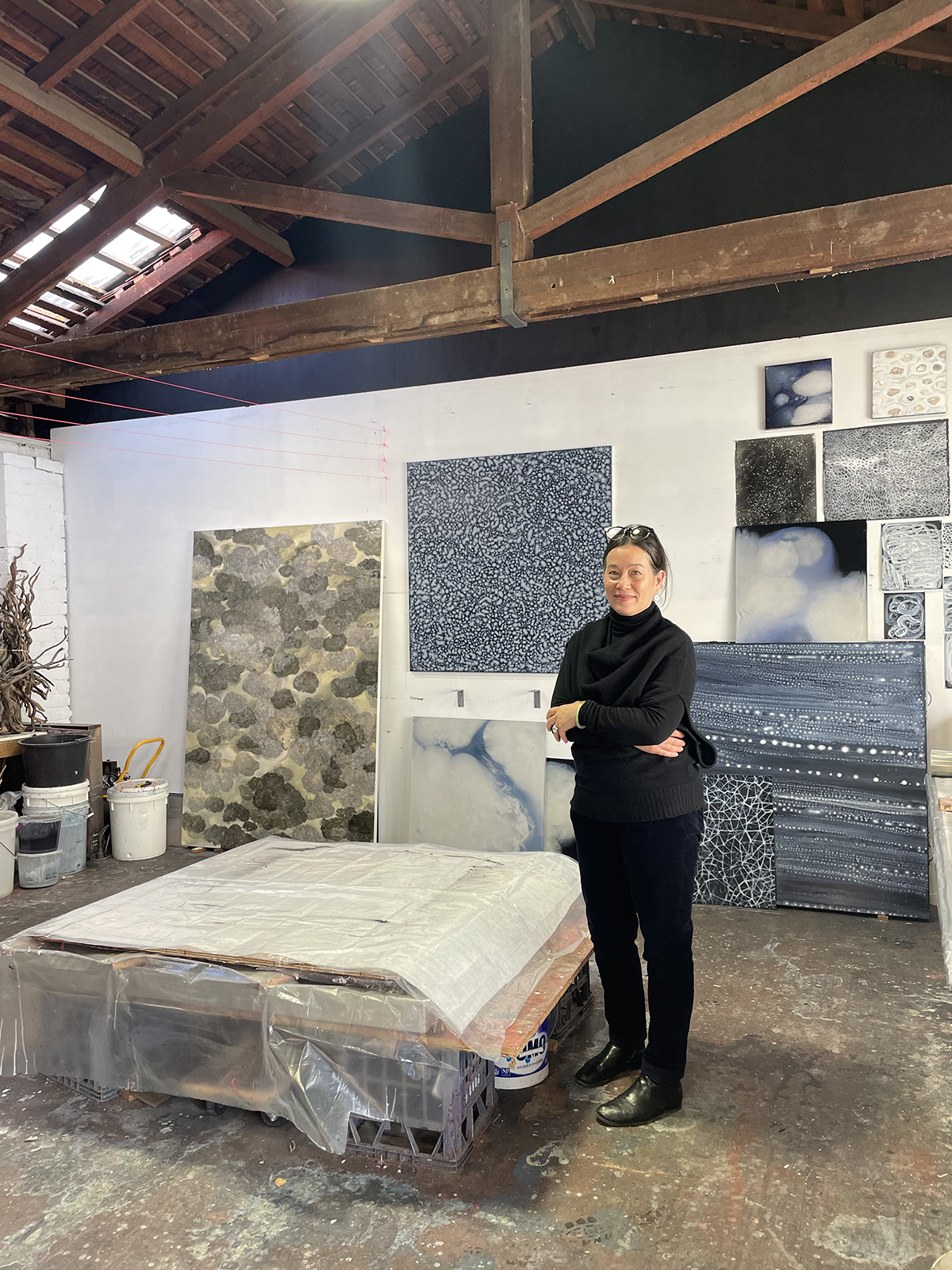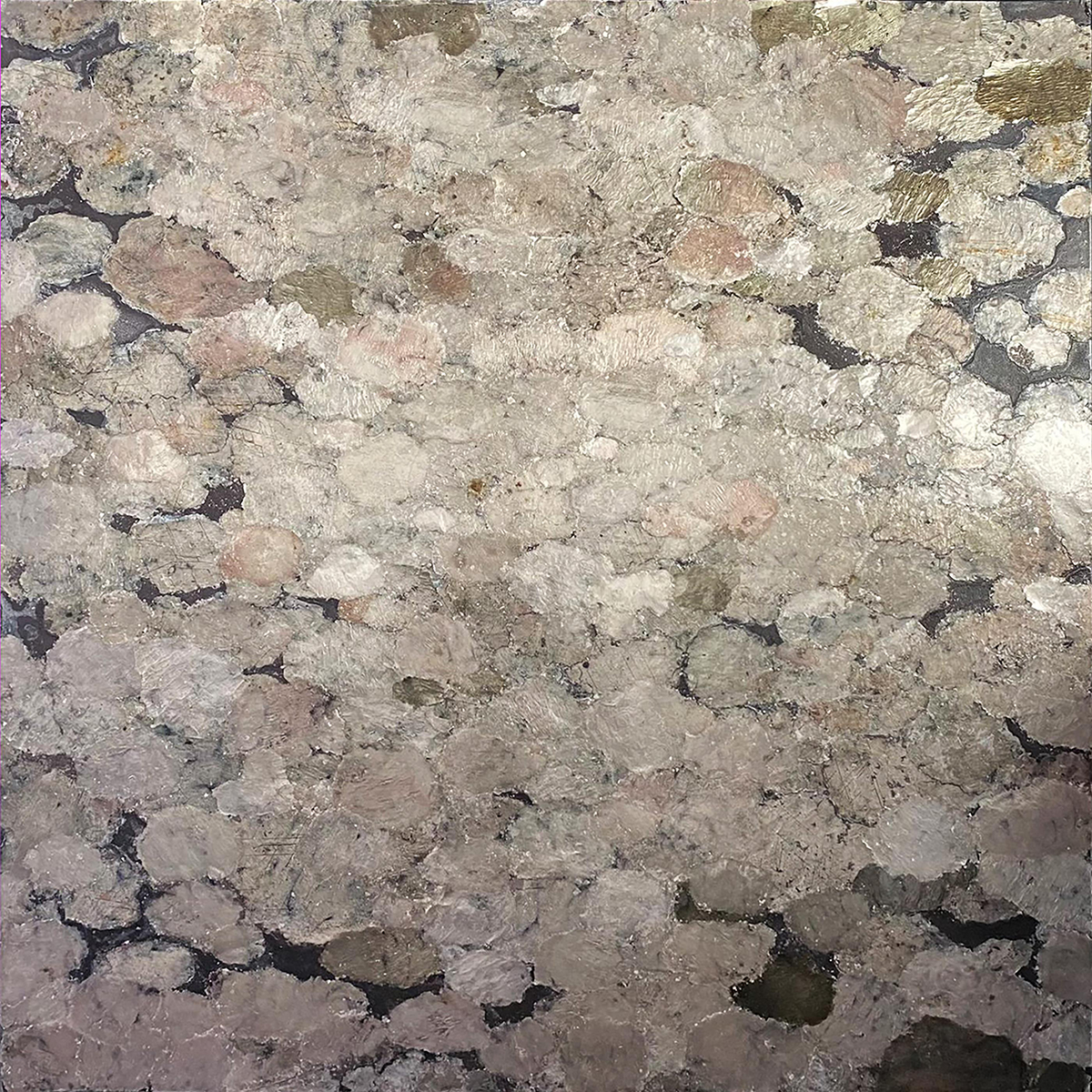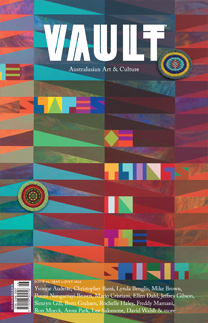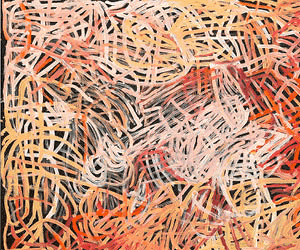Catherine Woo: A natural touch

Image credit: Portrait of Catherine Woo in her studio, Hobart, 2022. Photo: Sophie Prince for VAULT
In many ways, it is through holding a steady, specific and focused gaze upon the world that the profundities and intersectionalities of the universe may reveal themselves with nuance. Whether for example, it be the lens of gender, race or colonization that you hold up with a steady hand, all of these perspectives inevitably converge through in the process of following a single track. For Tasmanian-based artist Catherine Woo, the interrelationship between nature and the body has long been at the centre of her practice. This focus has guided the artist through macro to micro speculations of natural systems, material studies and intuitive spiritual understandings that unwittingly have been shown to connect to far-reaching and ancient beliefs. In line with the artist’s inclusion in the finalists exhibition of the 2022 Hadley’s Art Prize for her mesmerizing work A Moment in the Day (2022), VAULT sat down with Catherine to discuss where her work has taken her and what might be next – although conversation reveals that the artist’s embodied process of spending time in nature, studying the weather and mapping the materiality and forces of the environment in many ways falls short in verbal description with the work itself offering the closest answer.
Thank you so much for meeting with me and chatting today about your expanded practice. Your work has long maintained an engagement with nature – the natural world operating as both the subject and materiality of your work. Within this enduring framework, are you able to pinpoint any recent shifts in your practice?
I've been using a lot of natural materials in my work for quite a long time, and I've been interested in how those materials act and interact with each other. I suppose perhaps what's changed most in recent years is using more natural forces to create the works rather than just the placing of the materials. I’m interested in how as an artist I may activate a natural force or process that will then engender changes in the materials, resulting in a kind of, collaborative process between myself, material and natural forces.
In light of how new environmental forces are coming to collide due to climate change, do you think your work speaks to climate issues? Or is this connection more so an inevitability rather than an active one?
I'm certainly very interested in considering this dire position with the environment that we are in today. So by virtue of this and humans' inextricable relationship with our environment, which underlies everything that I do, I would say yes. I suppose this is represented most distinctly in my process of unpacking the division or perceived division between humans and nature, which I see as being the root of the problems that we are living with at the moment. As I see it, we have come to view ourselves, or at least many of us for a significant amount of time, have seen ourselves as the controllers or the top of a hierarchy in a pyramid of dominion over the land. My thinking and practice is a counter to this notion – it is dedicated to seeing ourselves as part of a bigger system, and understanding that we're a small part in a much larger process of interaction. I'm trying to put the body back into the landscape.
For me it’s an important universal truth that we are one with nature – it’s an expansive outlook that I could mull over for perpetuity. I imagine for you as well – so how do you hone your focus to unpack this infinite network of ideas? And what are you thinking about at the moment in terms of the body, the environment and your studies of nature?
I suppose what I'm trying to do is to first of all allow myself to experience things in nature. From this point I'm really looking at trying to distill a reaction to that sensation. Then – and I don't want to use the word represent – I sort of create something that promotes that sensation in someone else… That perhaps sounds a little vague.
Well, it's so hard to articulate a whole or embodied experience. For me that's what art does – it’s a vessel for making an impact. It's really hard to articulate the impact you want art to have, sometimes you just have to let it be.
Yeah – nature is beyond words and beside words. But I have been thinking about the importance of the material nature of the work that I do, particularly within the modern context when so much is digitized and or accessed online. Perhaps the enduring strength of the work that I do is how each piece is responsive to the environment that it sits within, eliciting a relationship between materials and the viewer. In some ways I see it as an answer to a kind of psychic deficit that a lot of people have – perhaps a yearning for the real. We live in a world that's constantly mediated and so we perhaps have a sense of there's something missing – the sensuous – and so although there aren’t always opportunities for people to experience nature or step away from the digital, art that is connected to nature and encourages presence may offer some respite.

Image credit: Installation view of Catherine Woo’s studio, Hobart, 2022. Photo: Sophie Prince for VAULT
You have lived, studied and practiced in a few different cities – Sydney, Canberra, Melbourne for example – and now you're in Tasmania. Can you tell me about how Tasmania is impacting your practice?
I think that being in a city like Hobart means you can perceive the changes in the atmosphere, the weather and the environment much more readily as compared to a place like Melbourne or Sydney. So I guess having access to perceivable changes in the environment in a sort of immediate and tangible way is really important to my practice. Having said that, the concerns that are central to my practice haven't really changed since I've moved here. They were present wherever I've worked but they're probably more influenced by spending time living in the bush or in the desert – these experiences have profoundly influenced the way I see the landscape.
You've also had an extensive education – completing your Bachelor of Arts at Sydney College of the Arts, a Graduate Diploma of Art at ANU and an MFA at the University of Tasmania – can you tell me a little bit about how art school and education in the formal sense plays out in your work and also how it diverges?
Gosh, good question – I mean, going back to early days in Sydney, there were a couple of teachers who lectured there that just helped me realise what I was doing. They could see what I was doing and just gave me some guidance – they asked me to look at a few different artists which helped me to confirm, yeah, this is what I'm doing. But more recently I think, the intuitive kind of responses I've had to portraying ‘landscape’ through doing a master's here in Hobart has probably helped me to understand more fully what it was that I was trying to get away from – which is sort of a single perspective outlook and getting away from ideas of landscape being owned and separate from the viewer. Moving beyond the idea of simply viewing the landscape and moving towards much more sensorial work has been really critical.
I think it’s so important to have a few different audiences encounter your work in different conditions – such as the active and critical discussions that may unfold safely at art school or with galleriests. You can be privy in the early stages to how people read what you’re working on.
CW: That's right. I would also have to say that while I think that the emphasis on finding words in order to substantiate a position in the art world is important, it can be overwhelming too. This weight can perhaps also override some other important things which sort of just need to seep out rather than be pinned down.
I agree! And without saying too much, you're one of the 35 finalists in the 2022 iteration of the The Hadley’s Art Prize – Australia's richest landscape prize – congratulations! Can you tell me a bit about the work you submitted, specifically the work’s relationship to landscape?
CW: So,that work is called A Moment in the Day (2022). I suppose it's really about trying to capture a fleeting sensation that you can experience in the environment or in the landscape, which is I think is best described as a kind of shimmering light or an iridescent light. I have found myself very fascinated by that phenomena – it is something which is transient so I’ve been trying to find a way to capture or encapsulate this particular kind of reaction between light and time. It's a challenge but I found that the materials that I'm using at the moment do have that gentle glistening effect. The work is kind of a sensation more than an actual view.
It is a really captivating piece. I do really like how for this exhibition it’s positioned within the specific framework of the landscape tradition, because when you look at that work you frame it as a landscape but it is not a specific landscape. Rather the familiar glimmer it casts offers the potential for to be any landscape – or indeed all landscapes since everything is ultimately connected.
– End
Catherine Woo’s work A Moment in Time (2022) is on view in the finalist exhibition for the 2022 Hadley’s Art Prize at The Hadley’s Orient Hotel in Hobart until August 21, 2022.
Catherine is represented by ARC ONE Gallery, Melbourne and Beaver Galleries, Canberra.
hadleysartprize.com.au
arcone.com.au
beavergalleries.com.au

Image credit: Catherine Woo, A Moment in Time, 2022, mixed media on aluminum, 120 x 120 cm. Courtesy the artist
Click here to Subscribe
























